 June 2015 Tank of the Month
June 2015 Tank of the Month
June 2015 Tank of the Month
Greg Timms' (Oldude) 404 US-gallon Reef Aquarium
 |
Introduction
Once again I am humbled to be in the company of those accomplished “reefers” who have inspired us in Reefkeeping Magazine’s TOTM articles. Being nominated for Reefkeeping Magazine’s Tank of the Month is an accolade to be treasured and to be nominated for a second time is truly special.
That said, writing a second article on the same tank presents an interesting challenge so to avoid redundancy I will not get into all of my background information and the usual “what got me into reefing” stories because that can all be found in my other TOTM write up. If interested in some history regarding the original tank build please click the link to view my April 2010 TOTM article.
A lot has happened in regards to my reef since April 2010. For example, I did a major “do-over” in November 2013 so to be honest I was actually reluctant about accepting this TOTM nomination because in my opinion my reef still has a long way to go before it’s up to “standard” with enough mature colonies for a real WOW factor. But as the saying goes, “it is what it is” and in my opinion much of the enjoyment in having a reef is watching it grow & being able to share it with others. So after all is said and done I am delighted to be able to share my “Little Reef on the Prairie” with you.
Background
In the summer of 2010 my display started to go downhill and never fully recovered - things would get looking ok for a while then go south again. I dealt with plenty of coral killing issues: Acropora Eating Flat Worms, Montipora Eating Nudibranchs, mojano & mini carpet anemone infestations and other problems stemming from something in the system I suspect was toxic. I thought it may have been caused by bad “salt” or bad “activated carbon that turned rusty” or a highly impure batch of “Dow-calcium chloride” or a bad batch of “DI resin”, etc. etc. All these “negatives” did actually happen over the course of time and likely contributed but it was growing increasingly hard to pinpoint the root cause and place the blame on any single event. In my opinion one of the challenges with keeping SPS is; when things are not going well you need to figure out what changed a week or two prior to the corals showing their current symptoms. (Yet another reason to go slow and don’t change a bunch of things in your system at once) Anyway, I believe that there may have been something leaching from inside my live rock because there was an apparent SPS killing substance in the tank that I couldn't test for and surprisingly running extra activated carbon & “Poly-filters” were of no help. I even sent water to be tested at a lab but their tests were inconclusive and gave no reports of anything toxic so I think it’s safe to say the source of the problem must be fairly obscure in the aquarium world since nobody, at least that I could find seems to have a test for it so unfortunately this still remains a mystery. By the end of 2010 & early 2011 my tank was an absolute mess with loads of dead corals. I pulled many of them out, (see picture of buckets below) and took out about 1/3 of my rock & replaced with dry Marco rock hoping that would be enough to remedy the situation but as luck would have it things only stabilized for a short time. I tried adding corals a few more times hoping I would get lucky & attain some success but my efforts were in vain. I was counselled by a few friends in the hobby that I should probably face the inevitable and start over but I was stubborn and felt overwhelmed when thinking about all the work a project like starting over would entail. So long story short, I tried nursing the display tank back to health several times but as stated it just wouldn’t fully recover, it would be okay for a few months so I would get my hopes up and then things would start to decline again.
Unfortunately my problems didn’t stop with the corals dying - I also had a few fish issues; one example is a few previously well behaved fish turned rogue after several years of being model citizens and then one day they started eating my LPS corals and clams to the tune of several thousand dollars. Ironically when fish get a taste for corals they always seem to like the more exotic & expensive pieces – I guess they must look more inviting and perhaps brighter colored corals taste better, who knows?
I also ended up with velvet in the tail end of Dec 2011/Jan 2012 which killed over 50 of the fish in the system. This was a painful event to go through and happened when I added two small fish without quarantining. I bought a yellow clown goby & small leopard wrasse at a “Boxing day” sale, (for you Americans - boxing day is a holiday the day after Christmas in Canada & the UK and stores often run sales comparable to “Black Friday”) each from a different store so I have no idea which one was the “Typhoid Mary” fish who caused this plague. Anyway, I put them into the display where they immediately hid in the rockwork and I never saw either of them again but within three days afterwards several fish started looking sick and within a week I had 95% of the fish looking really bad with velvet and cloudy eye. Some had their eyes so fogged over that they were blinded and running into things so I think they likely starved to death while others just had a thick looking whitish velvet coat and died. It was a hard thing to watch. I tried adding some medicine a few times but I’m not sure how much it helped. The disease eventually ran its course over the next 5-7 weeks and I could count the fish that lived on my fingers. Due to this event I now only have two of my original fish left that I bought in 2004 – a well behaved Coral Beauty & a Yellow Tang. The others that lived through the ordeal were my Marine Beta, Purple Tang, Naso Tang, Regal Tang, Foxface & two Pyramid Butterflies. These last four fish afterwards turned into the coral & clam nippers I referred to previously that cost me a fortune so they had to go. The Naso still has cataracts on its eyes from the scars left from the cloudy eye that was part of the velvet disease but is healthy & fat with lots of personality. The remaining survivors have no visible evidence from the disease and are also fat & healthy. On a side note - I have now decided that I will not put another foxface into any of my reefs because every single one I have owned eventually turned into a serious coral nipper after reaching maturity. I know fish can be hit and miss in their behavior but I have decided some fish just aren’t worth the risk. That said, ironically I keep a small one in my prop system for algae control but when it starts getting big I plan to trade it in at my LFS on something else.
During this time I was able to keep my prop tanks going because I fortunately had switched them into an independent system in 2011 so I was able to avoid most of those same issues in them. There were some very trying times during 2011–2013 and I even thought about going to a fish only tank or even shutting down but I soldiered on for the following reasons. Reason #1- when you have about 700+ gallons built into a house you’re kind of committed to make it work; reason #2- I really didn’t want to quit the hobby at a low point and feel defeated, but the third & main reason was that I still loved the hobby and knew what the tank could be again one day with perseverance. So now the real question was – am I prepared to do the time consuming hard work that would lie ahead to get things back to what they should be? It meant I would pretty much have to start over again, not totally from scratch but it would have to be pretty darn close. This “do-over” would now allow me to take out the closed loop, seal the holes & clean up some plumbing I was never happy with, etc.
In the spring/summer of 2013 I finally decided to do the inevitable and started to prepare for a rebuild & picked up a 130 gal tank with a sump & stand to house the transition - new rock, etc.
I mixed about 350 lbs. of dry rock; Pukani, shelf & branching together with about 50 lbs. of clean live rock from my system & about 30 lbs of new live Fiji rock into the transition tank which had been running for a couple of months with used water from my prop system (dumped the water from my weekly water changes into the 130 to get a bacteria jump start). It took a while for it to build it up but I believe that using this “known good” waste water made the rock “cooking” process go faster and considerably reduced the display tank cycle time as well because I actually added that same water to the display when I set it back up. Also during this time the 130 gallon tank in the fish room was still running so that also would help shorten cycle time.
I emptied out the old rock & sand, (although I kept about 10 lbs. of live sand to seed the new sand bed which worked really well) and vacuumed and cleaned the display. Once the tank was empty I sealed up the closed loop holes and let that cure & dry for about 10 days while we went on vacation. Upon our return I mixed up about 300 gallons of new water and as mentioned pumped the water from the 130 into the display and proceeded to set up the aqua-scape. I had a pretty good idea of what I wanted it to look like which in truth is not all that different from what it used to be but with more open spaces, etc. I do my best to create a space that will eventually grow into a fairly natural looking “coral-scape” and hopefully I am achieving that taking into consideration the numerous limitations of a glass box. Once the initial rock work was in place I moved the fish back in and threw in a few test corals. The “test pieces” did well so over the course of the next month I continued to add in the rest of the corals I had on hand. I also bought some colonies from a few fellow hobbyists that were shutting their tanks down which helped fill in some empty spaces but that said I started the majority of the corals from frags or small pieces. Several pieces were started from tiny frags – literally from “crumbs” that I was able to save from dying corals that I had over the years.
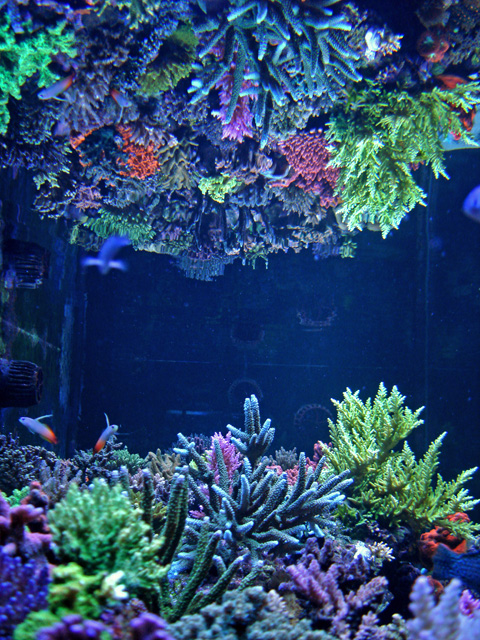 |
Tank Transition
Seeing these corals grow from those tiny fragments into what is becoming a beautiful colony again is something that has been very rewarding. For me it’s always interesting to watch a “frag” change colors before it finally settles into its natural pigments. What is also very cool is on the odd occasion a tiny fragment can morph into something even more spectacular than the mother piece it came from with an interesting blend if colors.
In my old system I thought I was pretty good about dipping corals previously but obviously I had missed some eggs so I now take more precautions. That said even with the extra precautions I still ended up with some AEFW in the new system likely from hidden eggs in nooks & crannies that I missed when introducing new corals so I added about 100 peppermint shrimp to the tank and they did a good job in eradicating them. I think I have about 30 peppermints left because I captured many and sold them to other hobbyists. That said the population number is only a guess because they are nocturnal and I just don’t see large numbers sitting around waiting to be counted. Although I have never personally tried them, I understand camel shrimp will do a great job on AEFW as well but they are only recommended in a QT as they will eat the corals after the flatworms are gone whereas peppermints are much less aggressive to SPS however I have witnessed them eating snails and digging into some LPS corals so they are not a perfect solution but it sure beats losing everything again. I have found no sign of flatworms in quite a while and can say this because I take out anything that looks suspect (coral losing color or showing signs of possible STN) as well as random pieces throughout the reef and perform a “Bayer” dip and I am finding no bite marks on the corals or AEFW in the bucket when done.
One surprising discovery I recently made was my large pink brittle star (easily 16 inches leg tip to leg tip) is not “reef safe” and was eating corals, in particular LPS. It would hide under a shaded area and stretch its long spiny legs out and literally rake the flesh off corals it could reach. I had been wondering why many of the corals in that immediate area had flesh receding until I witnessed the star doing it. Needless to say it was immediately removed from the display tank and relocated into the 130 gallon where it can do less damage. You can see an example of some of the damage it caused in the picture of the “war” favia.
I have experienced that while some corals really seem to like LED lighting others seem to prefer MH or T5. It has been somewhat surprizing discovering which corals seem to do well under the different lights and not always as I would have guessed. For example it’s been my experience that my Hawkins colony seems to stay brighter under the LED’s while my Red Planet stays a brighter red under MH and some other corals like Ricordia Florida seem to brighten up the best for me under T5.
I still have the same old SPS issues I’ve always had in which some corals look great with lots of color while some others have remained “under-performers” - It can be challenging to keep everything happy all the time. In my experience keeping a bunch of corals in a glass box, many of which don’t grow together in nature and are collected from different depths and environmental conditions can be a bit of a tricky balance when trying to meet their individual needs while being kept in a group setting. Also keeping my reef in top notch shape can be quite a challenge due to my work schedule but even with that it has been very rewarding because despite the challenges I have been seeing positive results again.
You’ll see my systems are run “old school” & basic – I have played the ULNS game in years past and although I had pretty good results it is just another thing to maintain in an already too busy life and for the most part I am reasonably pleased with the results I am getting without any carbon source dosing.
Although my tank is SPS dominant and Acropora are my favorites I am fond of other coral types as well so I don’t limit myself to just SPS and to quote an old cliché “variety is the spice of life”.
130 Gallon Aquarium
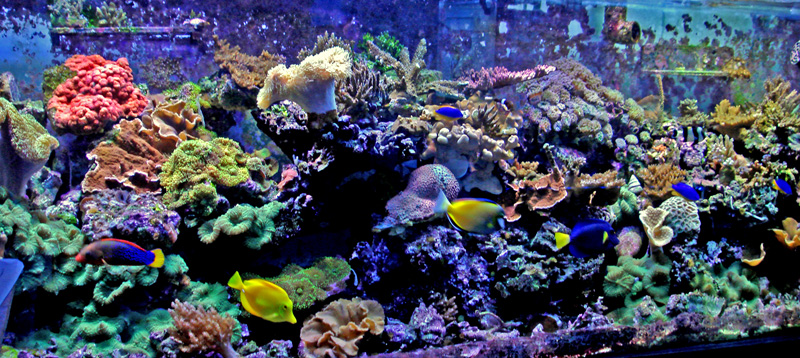 |
System Profile
• Main Display: 404 US-gallon 96in x 36in x 27in
• Total Water Volume: 725 gallons
• Second Display / Holding Tank: 130 US-gallon 72in x 18in x 24in
• Skimmer: Euro-reef RC500
• Water Circulation: Vortech - MP40WP x4 & MP60WP x3
• Reactors: Single phosban running ROX carbon (activated charcoal)
• Doser: Fauna Marine "GHL" stand alone (got rid of the GHP controller),Randy Holmes Farley's 2-part recipe
• RO unit: BRS 300 GPD
• Heaters: 300 watt x2 in display sump & one in prop system sump
• Auto-feeders: Rena filled with 1MM pellets
• Salt: Reefers Best
In the spring of 2012 I took the Hammerhead pump for the closed loop offline and added the first of three MP60 powerheads. Interestingly enough the single MP60 has close to the same GPH output as the large Hammerhead pump and once I stopped running that pump the temperature in my tank dropped by about 3 degrees Fahrenheit not to mention the bonus of the system being much quieter. Interestingly enough my chiller broke down around the same time but with the added bonus of the tank temperature drop & since my tank is in my basement – (oh and did I mention that I live in a typically cool climate?) – I have not bothered to replace the chiller and things have so far been fine without one.
Lighting
Lighting is comprised of the following:
Display
* In the front half - 4 Phoenix DE MH 14K bulbs, 4 x 250 watt Lumen Max-3 HQI pendents driven by 2 X Blue Wave double HQI ballasts & in the rh front corner is a Radion LED fixture
* In the rear half of the tank is a mix of 12 x 48" T5 bulbs (actinic, Fiji Purple, super blue, daylights)
* I also have 3 x Reefbrite blue LED fixtures running length wise across the center of the tank
130 Gallon
LED 2 foot fixtures x3
Prop tank
Phoenix DE MH 14K bulb x2, 250 watt Lumen Max-3 HQI pendants x2 driven by a Blue Wave double HQI ballast
Display Lighting Schedule:
8:00 AM - 12:00 AM (on all day for that little extra)
LED moonlights are made up of "Reefbrite" 3 watt diodes x 18 & an extra strip of 1 watt x 12 diodes.
9:30ish AM - 11:00 PM - T5 actinic & Fiji Purple (4 bulbs) start - stay on all day (runs for 14 hours)
1:00 - 1:20 PM all remaining lights come on & run until 9:00 - 9:15 PM. The T5's and the Radion are on the same timer and come on at 1:00 PM. The metal halides are divided amongst 2 timers and set up with the two outside lights together & the two inside lights on the other timer. This provides a better sunrise/sunset affect - the inside two stay on about 15 minutes longer since in my opinion this gives a more natural appearance resembling the last minutes of sunlight shining through a section of reef with the rest going darker. At this stage it is back to the four T5 actinic/Fiji purple bulbs & LED moonlights until 10:30 PM when it turns to just the LED moonlights and the reef goes dark at midnight.
In my opinion this lighting mix gives me a pretty good balance, with MH in front I still get some good shimmer while the T5's smooth things out.
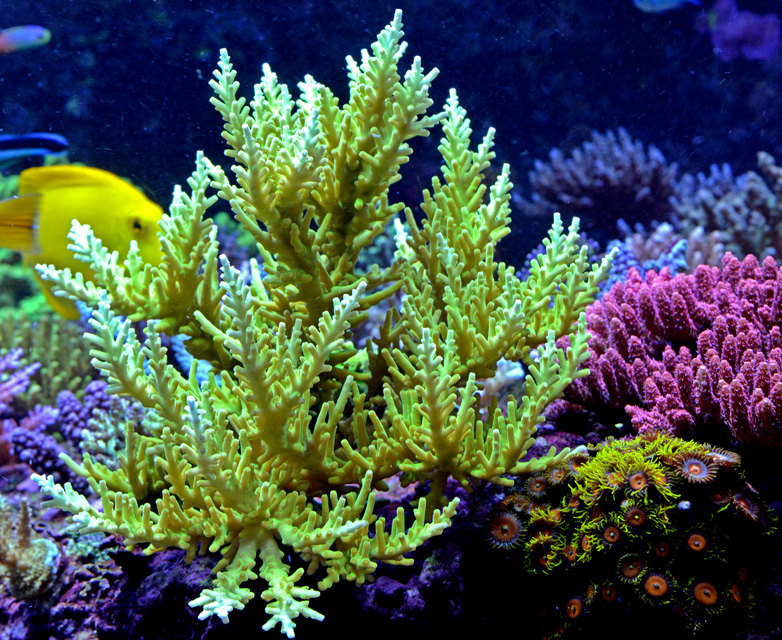 |
Parameters
I would love to say my parameters never fluctuate however as corals grow and their demands increase I need to make adjustments. In any case I do my best to keep them as close to natural sea water as possible.
|
Water Parameters:
|
Husbandry & Routine Maintenance
* In February 2015 I decided it would be a good idea to get back to basics so I started up a “macro-algae” refugium in the sump to help with nutrient export since I don’t run ULNS. I took out the crabs I had living in the sump because they ate all the “chaeto” in the previous one I ran. I decided to go with a mix of chaetomorpha & caulerpa since they are both fast growers and placed them in separate egg crate chambers so they don’t overgrow each other. I run a 24 hour light cycle on the macro-algae to maximize growth and minimize the chances of the caulerpa going “sexual”. I believe it is helping to reduce phosphates - it has to be since the algae is growing very fast and the coral colors seem to be improving. I have the refugium set up with the egg crate “chambers” running the full width of the sump so all the water passes through it before getting to the return pumps so I think it helps act as a bit of a scrubber. Each week as part of my water change routine I pull the chaeto out and give it a good rinse in a bucket of clean waste water. Afterwards the water in the bucket is really dirty so it always surprizes me how much detritus and debris gets caught up in that filtering “wall” of chaeto.
* I use Fauna Marin “balling solutions” mixed into the appropriate calcium & alkalinity reservoirs to ensure the system gets the necessary trace elements. I also dose Fauna Marin “Color Elements” on a weekly basis which helps to spike certain trace elements to enhance richer colors in the corals & it is my belief that it helps promote polyp extension in several sps corals. Interestingly enough I had pretty much taken the polyp extension for granted until I received a correspondence from Mike Paletta as well as several comments from other hobbyists asking if there was anything I was doing different to achieve it. First & foremost I think coral genetics is crucial but I also believe the right mix/amount of important trace elements may play a role.
Regarding the maintenance you will notice I described much of it as needed – to be honest some things are probably needed before I get around to changing them or cleaning them but I try and keep up with the important stuff on a regular basis.
* Dose KZ “sponge power” one or two times per week
* Weekly water changes of approximately 45 gallons or 6.5%
* Bi-weekly stir sump detritus after lights out to circulate back to display to feed corals
* Cleaning of Protein Skimmers as needed
* Testing of parameters bi-weekly
* Tracking tests & bulb change dates, etc. in a journal
* Change out MH bulbs yearly
* Change out T5 bulbs every 6-8 months
* Pre-Filter bags – change as needed
* Carbon – change out monthly
* Prune & frag corals as needed
* Top up dosing tanks as needed
* Top up auto feeders with pellets as needed
* Clean glass every 2nd day or as needed
* Change filters & membranes in RO unit as needed
* Apply muriatic acid for mojano control as needed
* Rinse Algae in sump weekly
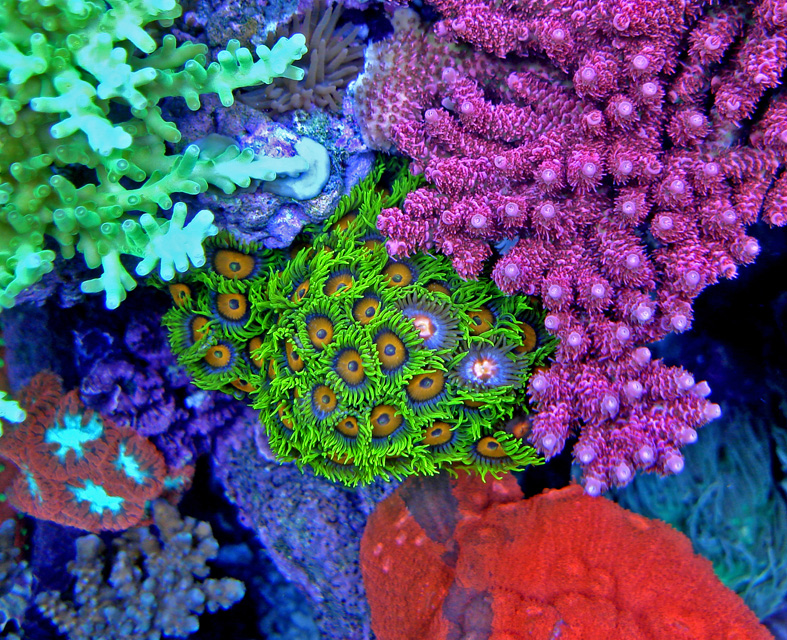 |
Fish & Inverts
Here is a list from the display tank:
WRASSES
Blue sided fairy wrasse
Cleaner wrasse x2
Leopard wrasses x2 (paired)
Melonaris wrasse
Mystery wrasse
Possum Wrasse
Ruby Head Fairy Wrasse
Yellow coris wrasse x2 (paired)
SURGEONS
Kole Tang
Naso Tang
Orange Shoulder Tang
Powder Blue Tang
Purple Tang
Sailfin Tang
Yellow Tang
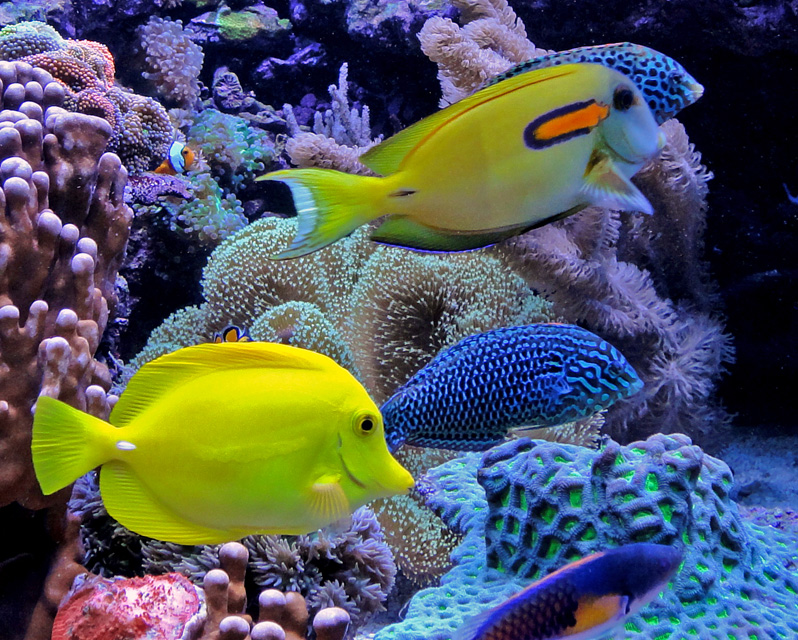 |
MISC.
Atlantic Blue Chromis x2
Blue Green Chromis x9
Clown Goby (yellow)
Coral Beauty
Disbar anthia
Dragon pipe x2
Firefish Goby x 3
Mandarin dragonets x2 (paired)
Marine Beta aka comet
Maroon clown
Orange spotted diamond gobies x2 (paired)
Royal gramma x2
Tail spot Blenny
True perculas x2 (paired)
Watchman Goby
Fire Shrimp x 2
Cleaner shrimp x2
Peppermint Shrimp x a bunch?
Large Brittle stars (2 large black)
Anemones x 4 (3 mini carpets & 1 rock flower)
Fish in the 130
Yellow tang
Purple tang
Powder Brown tang
Mature Red Coris Wrasse
Maroon Clown
Mandarin dragonets x2
Six line wrasse
Assorted damsels x6
Brittle Star 1 (XL pink that my son nick named “Creep-show”)
Feeding
Both tanks are fed by the use of “auto-feeders” and get a mix of 1-2 MM pellets. The main display is fed 4 times per day & the 130 gallon is twice a day. I have had good success feeding smaller amounts several times per day versus feeding a larger portion once a day since in the wild fish graze all day and this creates more opportunity for less aggressive eaters to be sure to get something every day. I also do not use a feed mode with the pumps but prefer to let the fish chase their food which to me just seems more natural. When I am home I sometimes manually throw in a little extra mostly so I can watch and enjoy a feeding frenzy and often feed some “Nori” for a little treat. Many of the fish, both tangs & wrasses eat it right out of my hand. I very seldom feed frozen foods – stinks up my basement and is extra work I don’t need. Regarding their main diet, if you are a fish in one of my tanks – you either eat pellets or hunt.
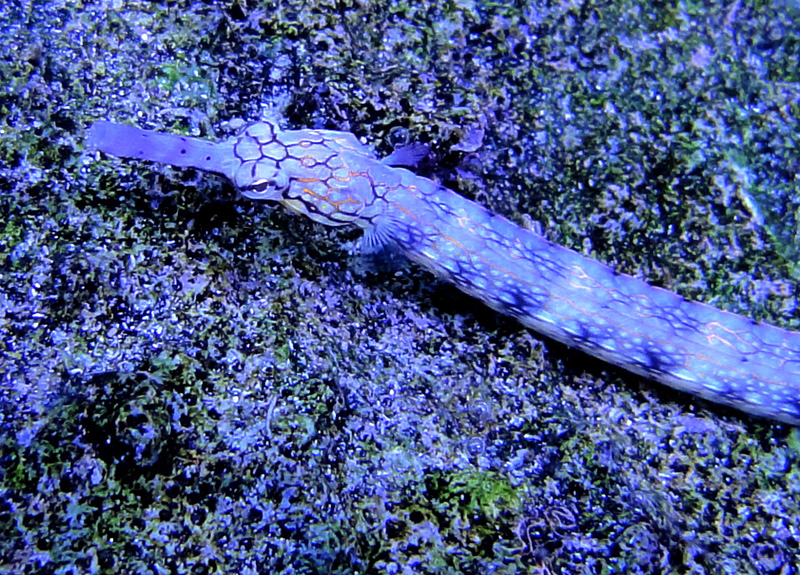 |
Corals
Of the approximately 250 corals in my main display there are still several that I am unclear on their exact ID and of course there are some species that I have duplicates of due to their variety of colors, etc. That said, below is a list of the corals in the reef that I have been able to identify with some confidence so for the most part it should provide the reader with a pretty good indication of what I have in the tank.
Small Polyp Stony Corals
Misc.
Cyphastrea japonica
Cyphastrea decadia
Hydnophora rigida
Heliopora coerulea (ok “Blue-ridge” is considered an “octocoral” not sps but it's hard & crunchy on the outside)
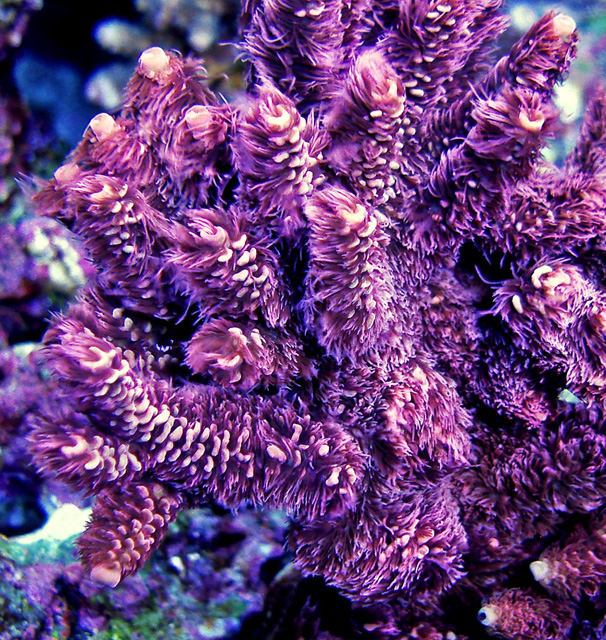 |
ACROPORA:
A abrotanoides
A aculeus
A austera
A awi
A carduus
A caroliniana
A cerealis
A chesterfieldensis
A convexa
A desalwii
A echinata
A elegans
A exquisita
A fastigata
A florida
A formosa
A gomezi
A grandis
A granulosa
A hoksemai
A horrida
A humilis
A hyacinthus
A insignis
A kosurini
A lianae
A loisetteae
A lokani
A Loripes
A loripes
A lovelli
A lutkeni
A macrostoma
A microclados
A microphthalma
A millepora
A nana
A nasuta
A natalensis
A papillare
A parahemprichii
A plana
A prostrata
A pulchra
A robusta
A sarmentosa
A secale
A solitaryensis
A spathulata
A speciosa
A subglabra
A subulata
A tenuis
A tortousa
A tutuilensis
A valida
A vermiculata
A willisae
A yongei
Etc.
MONTIPORA:
M capitata
M capricornis
M confusa
M digitata
M mollis
M samarensis
M setosa
M undata
Etc.
SERIATOPORA:
S caliendrum
S hystrix
Pocillopora
P damicornis
Stylophora
S pistillata
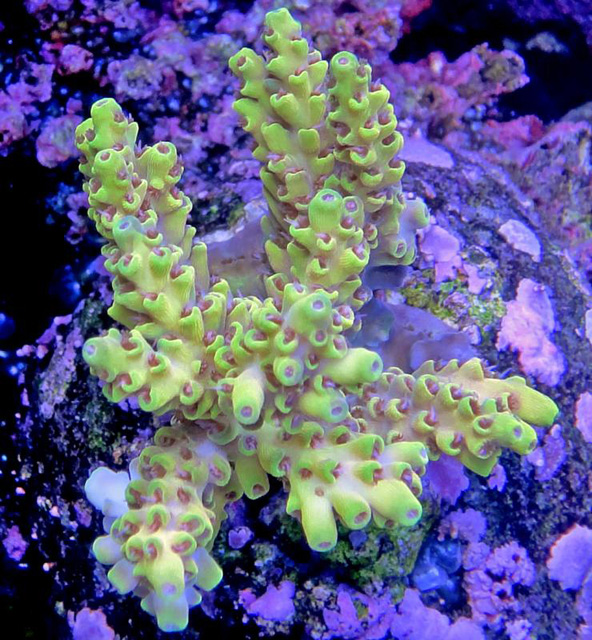 |
Large Polyp Stony Corals
Acanthastrea echinata
Acanthastrea lordhowensis
Blatsomussa sp.
Catalaphyllia jardinei
Caulastrea furcata
Duncanopsammia
Echinophyllia aspera
Echinopora sp.
Euphyllia ancora
Euphyllia divisa
Favia speciosa
Favites halicora
Fungia sp.
Goniastrea palauensis
Lobophyllia sp.
Micromussa sp.
Pavona decussate
Symphyllia sp.
Etc.
Soft Corals & Corallimorpharians
Cabbage Leather
Gorgonians – Assorted photosynthetic
Kenya Tree
Rhodactis sp. – Assorted
Ricordia Florida
Ricordia Yuma
Toadstool Leathers
Zoanthus/Palythoas - Assorted
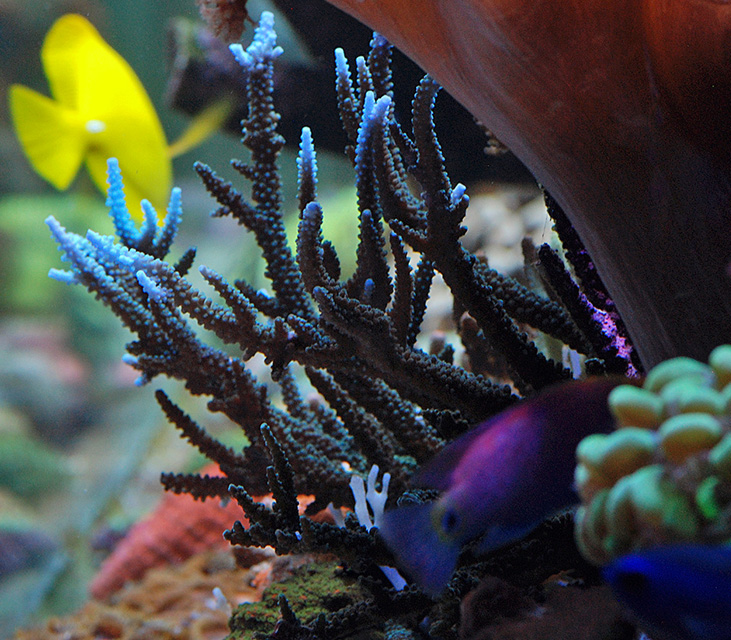 |
Acknowledgements & Closing Remarks
The reason I have the opportunity to have my small piece of ocean and share it with you is because of the support and freedom given to me by my amazing wife Penny who encourages & supports me in whatever I do. Although she isn’t directly involved in the build or day to day husbandry of her husband, I couldn’t have done it without her.
A great big thank you goes out to all of you on Reef Central who nominated me for Tank of the Month; your support is greatly appreciated. A good part of my impassioned feelings for this hobby comes from the continual support of my peers and it’s a tremendous compliment when I hear from people telling me that I helped inspire them or they want to model their set up based on mine. That is a really special feeling so thank you. I guess it’s safe to say in the hobby most of us have some sort of influence on each other as I continue to be inspired by others and their abilities and I can think of many “reefers” who are more deserving of recognition than I.
My wish is that your time in the hobby will be a rewarding experience for you and perhaps reading this article may help some of you avoid making some of the mistakes I’ve made over the years. I trust that through my pictures & written word, even though my writing skills are extremely limited, you have been provided with some insight of my passion for reef keeping.
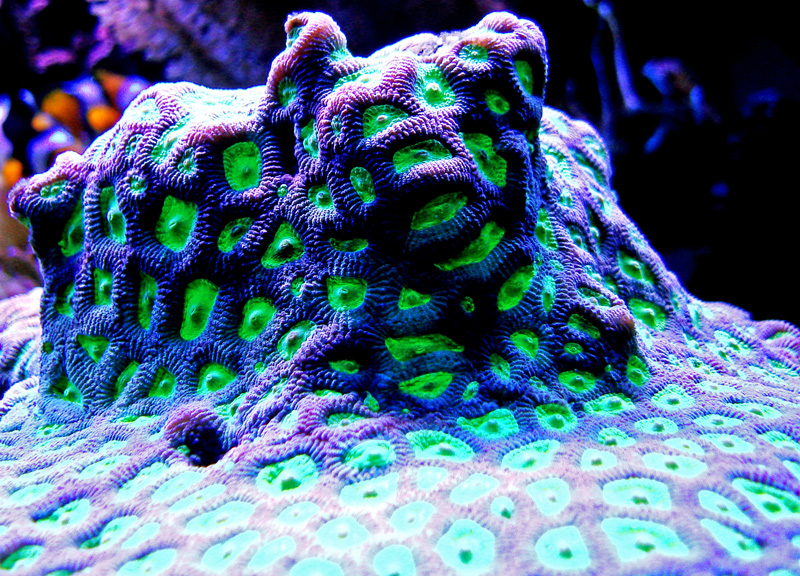 |
Feel free to comment or ask questions about my tank in the Tank of the Month thread on Reef Central.



